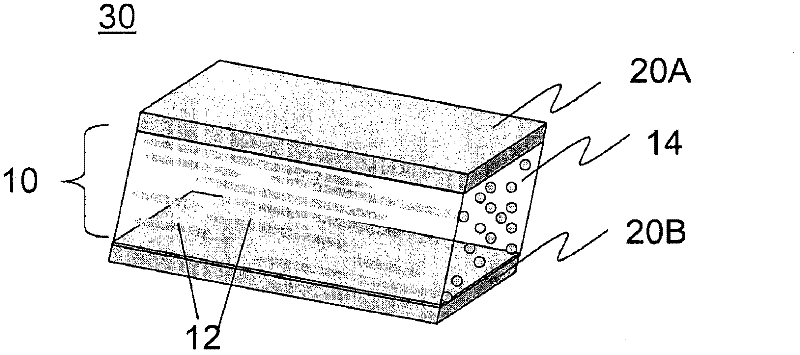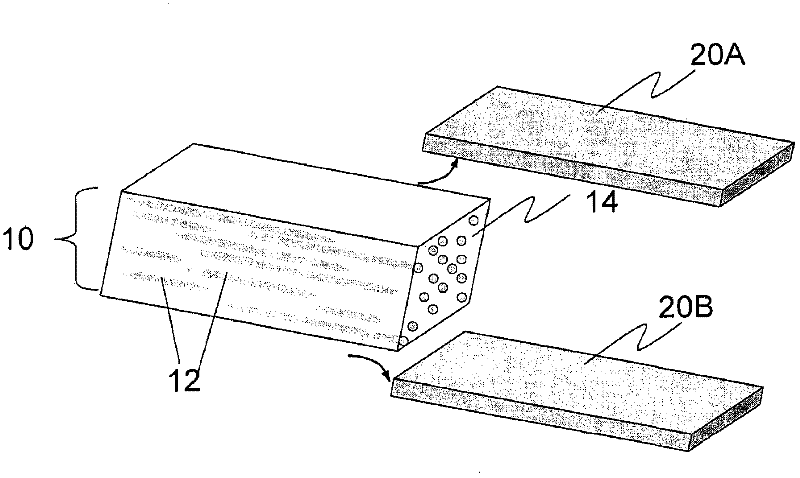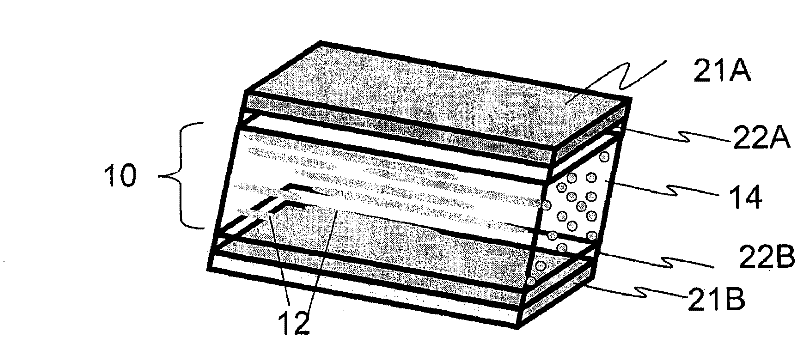Method of manufacturing a diffusely-reflecting polarizer having a nearly isotropic continous phase
A technology of polarizer and diffuse reflection, which is applied in the direction of diffusion elements, polarizing elements, instruments, etc., and can solve the problems of limited use
- Summary
- Abstract
- Description
- Claims
- Application Information
AI Technical Summary
Problems solved by technology
Method used
Image
Examples
Embodiment
[0061] Diffuse reflective polarizers according to the invention are made by extruding a mixture of a first polymeric phase and a second polymeric phase. The dry component mixture is fed into the single screw extruder at the desired composition. The mixture was coextruded through a multi-manifold die with protective layers on both sides of a film of the immiscible mixture comprising the two phases described above. After exiting the die, the cast sheet passes through a three-roll stack including a pair of calender rolls to improve its surface quality. After casting, the total thickness of the flakes was about 800 microns, and the total thickness of the protective layer was about 1 / 4 of the total thickness of the flakes. The three-layer cast sheet is then stretched in the machine direction to induce birefringence in the birefringent disperse phase.
[0062] The sheet is first heated to the nominal stretching temperature T s, and then stretched by a factor of 3 to 5 in a uniaxi...
example 1
[0070] Example 1: Pure continuous phase polymer Topas 8007, SB, Zylar 631, PETG 6763 and PCTG 5445 were coextruded with PET or PEN protective layer and stretched under the same conditions as the mixture including continuous phase and dispersed phase, That is, the same stretching temperature and stretching ratio are used. The epidermis is then peeled off. The refractive index n at a wavelength of 633 nm of each core layer composed of a pure amorphous polymer was then measured using a Metricon prism coupler 2010 from Metricon Corporatopm. para , n perp and n z . Refractive index n para , n perp and n z Corresponding to the direction parallel to stretching, perpendicular to the direction of stretching, and along the thickness direction of the sheet, respectively. In all three refractive indices n perp and n z are very close to each other, the difference between the two of them is less than 0.02, and in most cases the difference is less than 0.005. Refractive index n of ...
Embodiment 2
[0071] Example 2: 70% by weight of Zylar 631 is used as the continuous phase polymer, 30% by weight of PEN is used as the dispersed phase polymer, the protective layer is PEN, and stretched 5 times along the direction of the extruded film at a temperature of 125°C. The sample had a FOM value of 1.66, a total reflectance of 83%, a diffuse reflectance of 71%, and a specular reflectance of 12% (all measured at 550nm).
PUM
| Property | Measurement | Unit |
|---|---|---|
| thickness | aaaaa | aaaaa |
| refraction | aaaaa | aaaaa |
| refraction | aaaaa | aaaaa |
Abstract
Description
Claims
Application Information
 Login to View More
Login to View More - R&D
- Intellectual Property
- Life Sciences
- Materials
- Tech Scout
- Unparalleled Data Quality
- Higher Quality Content
- 60% Fewer Hallucinations
Browse by: Latest US Patents, China's latest patents, Technical Efficacy Thesaurus, Application Domain, Technology Topic, Popular Technical Reports.
© 2025 PatSnap. All rights reserved.Legal|Privacy policy|Modern Slavery Act Transparency Statement|Sitemap|About US| Contact US: help@patsnap.com



